
This is a very important question that each business must answer in order to reach the highly sought-after B2B market. The answer is more complicated than you think.
Nuanced Expectations for B2B Customers
Because Hispanic millennials in the U.S. use both English and Spanish, marketers often recommend using Spanglish to reach them. However, this marketing is often targeted to retail consumers, not business buyers, and B2B communication is vastly different.
Companies are still experimenting with different strategies to reach Hispanic businesses in the B2B marketplace, but there is one lesson they have already learned: Hispanic business owners value professionalism just as much as any other business owner. That means that Spanglish, a very laid back and informal mashup of languages, may be inappropriate when communicating with B2B customers.
Your translated content needs to educate B2B customers on how your products and services can help them and how you can provide what they need, and it needs to do so clearly and succinctly. Casual language, especially hybrid lingo like Spanglish, can compromise the authenticity, integrity and trust that's so important to a B2B buyer.
Should Spanglish Ever Be Used in B2B Marketing?
There are times when a more casual tone can work in business marketing, but the important thing is to discern carefully when it's useful and appropriate.
If you have products or services that are targeted to young Hispanics — specifically millennials who grew up entirely in the United States — then Spanglish may be an approachable way to communicate with these audiences. Similarly, if you know that some of your users already strongly prefer Spanglish, you should continue to communicate with them in this way.
However, there are two important downsides to consider when using Spanglish for the B2B market:
1. Hispanics who were educated outside the U.S. may not be as adept at speaking Spanglish as those who were brought up there.
2. People whose first language is Spanish may not feel comfortable speaking Spanglish, so marketing in Spanglish can cause an immediate disconnect with these buyers. In fact, 34.2% of the U.S. Hispanic population is foreign-born, according to data from the most recent U.S. Census. That means Spanish is likely their first and most-preferred language.
Understanding Your B2B Customers and Their Language Preferences
Before you decide how to market to Hispanic B2B customers, you first need to understand who they are and how they prefer to communicate.
For the most part, decisions at Hispanic-owned companies aren't made by a single person; instead, they're often made by a team of people who speak varying combinations of English, Spanish, or Spanglish. Many of these decision-makers are upper-level managers who tend to be older and more conservative who view Spanglish as too relaxed for the workplace.
Providing information in both English and Spanish is a safe, professional approach that can ensure your content reaches every customer, no matter their preferred language. And you'll never have to wonder whether a too-casual Spanglish experience is turning off prospects and customers.
Source: Published originally on mediapost.com, Is 'Spanglish' The Right Way To Reach The U.S. Hispanic B2B Market? Maybe Not, by Craig Witt, May 3rd, 2018.